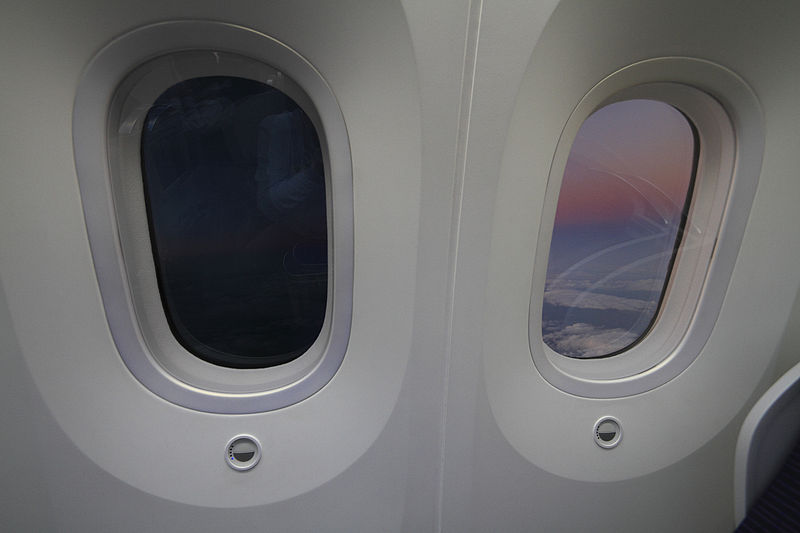Aerospace
How The Boeing 787 Dreamliner’s Dimmable Windows Work

A unique feature of the Boeing 787 Dreamliner is its dimmable windows, which enhance passenger comfort and overall experience. The Dreamliner’s windows employ an electrochromic technology, as opposed to conventional aircraft windows with physical shades.
Electrochromic windows are made of special materials that can change their tint or opacity when an electric voltage is applied. In the case of the boeing 787 dreamliner, There are two pieces of glass with a thin layer of gel between them. The gel’s opacity is altered chemically when an electrical current is applied to it.
The passengers cannot see the electrodes because they are positioned on the sides of the windows. Additionally, the windows are networked so that flight attendants can have centralized control.
A button or touchscreen control next to each passenger’s seat allows them to change the amount of tint in the windows. Passengers can control the amount of sunlight entering the cabin without using physical window shades with technology that allows a gradual transition from transparent to different shades of dimness.
These dimmable windows have numerous advantages. The crew can create a cosier atmosphere inside the cabin and passengers can enjoy the outside view without glare. In addition to reducing the need for conventional window treatments, the dynamic control over light also contributes to a sleek and contemporary interior design.
Furthermore adding to the dreamliners overall energy efficiency are the dimmable windows. The aircraft can better control its temperature and save fuel by minimizing the amount of direct sunlight and the need for physical shade.
Overall, the Boeing 787 dreamliner dimmable windows demonstrate state-of-the-art technology that improves passengers’ in-flight experiences while providing useful benefits in terms of energy efficiency and aesthetic design.

Aerospace
Boeing Transfers Rocket Stage to NASA, Paving Way for Human Moon Mission

Boeing has achieved a significant milestone by providing NASA with the second core stage of the Space Launch System (SLS) rocket.
This crucial component, crafted at NASA’s Michoud Assembly Facility (MAF), is set to propel the Artemis II crew into lunar orbit, marking humanity’s return to deep space after a 50-year hiatus.
The monumental Boeing-built rocket stage, the largest element of the Artemis II mission, will embark on a journey aboard the Pegasus barge, traveling 900 miles to NASA’s Kennedy Space Center.
Comparison of two legendary aircraft B777x vs B747 aircraft:Click here
Upon arrival, it will be meticulously integrated with other essential Artemis II components, including the upper stage, solid rocket boosters, and NASA’s Orion spacecraft within the iconic Vehicle Assembly Building. This intricate integration process is a vital step toward the eagerly anticipated Artemis II launch, slated for 2025.
“Boeing-built products helped land humankind on the moon in 1969, and we’re proud to continue that legacy through the Artemis generation,” remarked Dave Dutcher, vice president and program manager for Boeing’s SLS program. “Together, with NASA and our industry partners and suppliers, we are building the world’s most capable rocket and paving the way to deep space through America’s rocket factory in New Orleans.”
NASA, Lockheed Martin Reveal X-59 Quiet Supersonic Aircraft:Click here
The delivery of Core Stage 2 marks a significant achievement in the evolution of the SLS rocket. Towering over 200 feet and powered by four RS-25 engines, this core stage, coupled with two solid-fueled booster rockets, will generate a staggering 8.8 million pounds of thrust. This immense power is crucial to launching Artemis II and future missions into the vast expanse of space.
The SLS rocket stands unparalleled in its capability to transport both crew and substantial cargo to the moon and beyond in a single launch. Its extraordinary capacity will facilitate the delivery of human-rated spacecraft, habitats, and scientific missions to destinations including the moon and Mars, ushering in a new era of space exploration.
-

 Travel1 week ago
Travel1 week agoAir India to Expand US Operations with Three New Routes After a Decade
-

 Travel2 weeks ago
Travel2 weeks agoWhy We Should Avoid These Stamps in a Passport
-

 Airlines1 month ago
Airlines1 month agoInvestigations Reveal Fake Chinese Titanium in Boeing and Airbus Jets
-

 Tech4 weeks ago
Tech4 weeks agoChina’s CATL Plans 1,800-Mile Electric Plane Launch by 2027
-

 Airport3 days ago
Airport3 days agoTop 10 Largest Airports in the World by Size
-

 Aerospace4 weeks ago
Aerospace4 weeks agoChina’s Fighter Jets Turn Wings into Autonomous Drones
-

 Airlines4 days ago
Airlines4 days agoAir India Rolls Out A350s for Delhi-New York JFK and Newark Routes
-

 Defence3 weeks ago
Defence3 weeks agoBoeing Enhances Chinook with New Engines and Block II Upgrades at $96 Million







